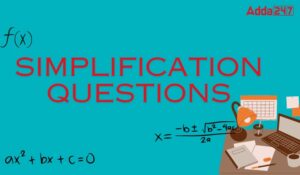Mixture and Alligation is a vital topic in quantitative aptitude, commonly tested in bank exams. It involves the blending of two or more components to form a mixture, and the concept is used to calculate the ratio or percentage of various substances in a solution. Mastering this topic enhances problem-solving skills, as it requires understanding proportions, averages, and basic algebra.
Mixture & Alligation Questions for Bank Exams
Mixture and Alligation Questions for Bank Exams help the Students score good marks in their Exams because the topic is limited with concept which can be mastered in few days. Practising these questions thoroughly will help the students boost their confidence as well as will help them excel in exams.
1. In what Ratio the grocer mix two types of pulses Costing Rs. 15/kg and Rs. 20/kg respectively to get a una mixture of pulses to get a mixture costing Rs. 16.50/kg?
a) 3:7
b) 5:7
c) 7:3
d) 7:5
Answer: d) 7:5
2. A vessel is filled with liquid, 3 parts of which are water and 5 parts syrup. How much of the mixture must be drawn off and replaced with water so that the mixture may be half water and half syrup?
a) 1/3
b) 1/4
c)1/5
d) 1/7
Answer: b) 1/4
3. 8 litres are drawn from a cask full of wine and is then filled with water. This operation is performed three more times. The ratio of the quantity of wine now left in cask to that of the water is 16 : 65. How much wine the cask hold originally?
a) 18 litres
b) 24 litres
c) 32 litres
d) 42 litres
Answer: c) 32 litres
4. A merchant has 1000 kg of sugar part of which he sells at 8% profit and the rest at 18% profit. He gains 14% on the whole. The Quantity sold at 18% profit is
a) 400 kg
b) 600 kg
c) 560 kg
d) 640 kg
Answer: b) 600 kg
5. A container contains 40 litres of milk. From this container, 4 litres of milk was taken out and replaced by water. This process was repeated further two times. How much milk is now contained by the container?
a) 29.16 litres
b) 28 litres
c) 28.2 litres
d) 26 litres
Answer: a) 29.16 litres
6. A milk vendor has 2 cans of milk. The first contains 25% water and the rest milk. The second contains 50% water. How much milk should he mix from each of the containers so as to get 12 litres of milk such that the ratio of water to milk is 3 : 5?
a) 5 litres, 7 litres
b) 4 litres, 8 litres
c) 6 litres, 6 litres
d) 7 litres, 4 litres
Answer: c) 6 litres, 6 litres
a) 1:4
b) 1:5
c) 1:6
d) 2:5
Answer: b) 1:5
8. A shopkeeper has 50 kg of rice. A part of which he sells at 10% profit and remaining at 5% loss. He gains 7% on the whole. Find the quantity sold at 10% profit.
a) 40 kg
b) 15 kg
c) 35 kg
d) 20 kg
Answer: c) 35 kg
9. Tea worth Rs. 126 per kg and Rs. 135 per kg are mixed with a third variety in the ratio 1 : 1 : 2. If the mixture is worth Rs. 153 per kg, the price of the third variety per kg will be:
a)Rs. 165.5
b)Rs. 170.5
c)Rs. 175.5
d)Rs. 180.5
Answer: c) Rs. 175.5
10. In what ratio must a person mix three kinds of metal costing Rs.60/kg, Rs.75/kg and Rs.100 /kg so that the resultant alloy when sold at Rs.96/kg results in a gain of 20%?
a)4:2:1
b)2:1:2
c)5:4:1
d)1:4:2
Answer: a) 4:2:1
11. How many kilograms of rice of Rs 6.4/kg should be mixed with 10 kg of rice of Rs 4.8/kg, in such that by selling the mixture at 20 % profit, which is Rs. 1.12 more than the average price per kg of both the varieties of rice
a)12 kg
b)15 kg
c)10 kg
d)11 kg
Answer: a) 12 kg
12. Three types of Rice of Rs. 1.27, Rs. 1.29 and Rs. 1.32 per kg are mixed together to be sold at Rs. 1.30 per kg. in what ratio should this rice be mixed.
a)1:5
b) 2:6
c) 3:5
d) 4:5
Answer: c) 3:5
13. How much does a shop owner mix 4 types of rice worth Rs. 95, Rs. 60, Rs. 90 &Rs.50 per kg so that he can make the mixture of these rice worth Rs. 80 per kg.
a)4:4:5:1
b) 7:4:2:3
c) 3:9:5:8
d) 4:6:5:7
Answer: d) 4:6:5:7
14. Two vessels A and B contain milk and water mixed in the ratio 4: 3 and 2: 3. The ratio in which these mixtures be mixed to form a new mixture containing half milk and half water is
a) 7: 5
b) 6: 5
c) 5: 6
d) 4: 3
Answer: a) 7:5
15. A milkman makes 20% profit by selling milk mixed with water at Rs. 9 per litre. If the cost price of 1 litre pure milk is Rs. 10, then the ratio of milk and water in the said mixture is
a) 3: 1
b) 4: 1
c) 3: 2
d) 4: 3
Answer: b) 4:1
16. In two types of stainless steel, the ratio of chromium and steel are 2: 11 and 5: 21 respectively. In what proportion should the two types be mixed so that the ratio of chromium to steel in the mixed type becomes 7: 32?
a)2: 3
b) 3: 4
c) 1:2
d) 1:3
Answer: b) 3:4
17. Two liquids A and B are in the ratio 5 : 1 in container 1 and 1 : 3 in container 2. In what ratio should the contents of the two containers be mixed so as to obtain a mixture of A and B in the ratio 1:1 ?
a) 2 : 3
b) 4 : 3
c) 3 : 2
d) 3 : 4
Answer: b) 4:3
18. There are two containers: the first contains 500 ml of alcohol, while the second contains 500 ml of water. Three cups of alcohol from the first container is taken out and is mixed well in the second container. Then three cups of this mixture is taken out and is mixed in the first container. Let A denote the proportion of water in the first container and B denote the proportion of alcohol in the second container. Then,
a) A > B
b) A < B
c) A = B
d) None of These
Answer: c) A = B
19. Cost of two types of pulses is Rs.15 and Rs, 20 per kg, respectively. If both the pulses are mixed together in the ratio 2:3, then what should be the price of mixed variety of pulses per kg?
a) Rs. 22 per kg
b) Rs. 30 per kg
c) Rs. 10 per kg
d) Rs. 18 per kg
Answer: d) Rs. 18 per kg
20. A dealer has 1000 kg sugar and he sells a part of it at 8% profit and the rest of it at 18% profit. The overall profit he earns is 14%. What is the quantity which is sold at 18% profit?
a) 250 kg
b) 600 kg
c) 620 kg
d) 400 kg
Answer: b) 600 kg




 Simplification Questions For Bank Exams ...
Simplification Questions For Bank Exams ...
 Quantity Comparison Questions for Bank E...
Quantity Comparison Questions for Bank E...
 Time and Distance Questions for Bank Exa...
Time and Distance Questions for Bank Exa...





